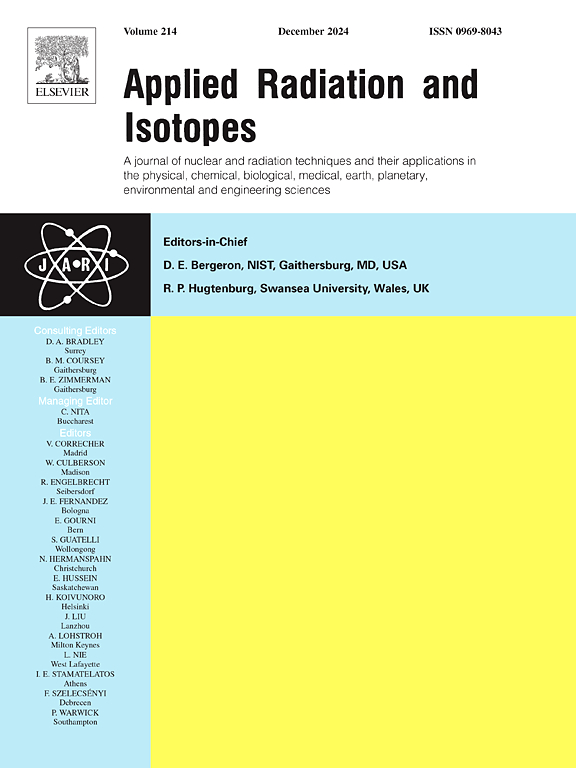Comparison of measurement techniques and sorption of radium-226 in low and high salinity aqueous samples
IF 1.6
3区 工程技术
Q3 CHEMISTRY, INORGANIC & NUCLEAR
引用次数: 0
Abstract
Human activities have the potential to redistribute radium (Ra) in the marine environment in a manner that may necessitate monitoring or management of subsequent human or environmental exposures. There is therefore a need to identify accurate and accessible techniques for Ra measurement in high salinity samples and to describe the distribution of Ra in estuarine and marine environments, but most efforts in these areas have focused on low salinity matrices. In addition, rapid and reliable measurements are crucial for time-sensitive samples such as short-lived isotopes or emergency situations. The objective of this study is to describe the limits of detection, cost, and relative ease for measurement of Ra in both low and high salinity aqueous samples via three analytical methods: liquid scintillation counting (LSC), high purity germanium (HPGe) gamma spectrometry, and inductively coupled plasma mass spectrometry (ICP-MS). To contextualize these measurements for real-world scenarios, the partitioning of 226Ra to substrates relevant to the marine environment was also characterized. Although HPGe detection with solid phase extraction had the lowest limit of detection for low salinity samples (0.27 Bq L−1), poor 226Ra recovery for high salinity samples and high materials costs make this method prohibitive for many users. Limits of detection for high salinity samples were lower for LSC (1.28 Bq L−1) than for ICP-MS without dilution (11.4 Bq L−1), but significant and unexpected degradation of the high salinity LSC standards was observed after six months. Therefore, our preferred measurement method for high salinity Ra samples is ICP-MS with sample dilution as necessary to reduce matrix effects.
低、高含盐量样品中镭-226的测量技术及吸附比较
人类活动有可能在海洋环境中重新分布镭(Ra),因此可能需要监测或管理随后的人类或环境暴露。因此,有必要确定在高盐度样品中测量Ra的准确和可获得的技术,并描述Ra在河口和海洋环境中的分布,但这些领域的大多数努力都集中在低盐度基质上。此外,快速和可靠的测量对于时间敏感的样品(如短寿命同位素或紧急情况)至关重要。本研究的目的是描述通过液体闪烁计数(LSC)、高纯锗(HPGe)伽马能谱法和电感耦合等离子体质谱法(ICP-MS)三种分析方法在低盐和高盐水溶液样品中测量Ra的检测限制、成本和相对容易程度。为了将这些测量结果与现实世界情景相结合,还对226Ra在与海洋环境相关的基质上的分配进行了表征。尽管固相萃取HPGe检测对低盐度样品的检出限最低(0.27 Bq L−1),但对高盐度样品的226Ra回收率较差,且材料成本高,使得该方法对许多用户望而却步。LSC对高盐度样品的检出限(1.28 Bq L−1)低于未稀释的ICP-MS (11.4 Bq L−1),但6个月后,高盐度LSC标准品出现了意想不到的显著降解。因此,我们对高盐度Ra样品的首选测量方法是ICP-MS,必要时进行样品稀释以减少基质效应。
本文章由计算机程序翻译,如有差异,请以英文原文为准。
求助全文
约1分钟内获得全文
求助全文
来源期刊

Applied Radiation and Isotopes
工程技术-核科学技术
CiteScore
3.00
自引率
12.50%
发文量
406
审稿时长
13.5 months
期刊介绍:
Applied Radiation and Isotopes provides a high quality medium for the publication of substantial, original and scientific and technological papers on the development and peaceful application of nuclear, radiation and radionuclide techniques in chemistry, physics, biochemistry, biology, medicine, security, engineering and in the earth, planetary and environmental sciences, all including dosimetry. Nuclear techniques are defined in the broadest sense and both experimental and theoretical papers are welcome. They include the development and use of α- and β-particles, X-rays and γ-rays, neutrons and other nuclear particles and radiations from all sources, including radionuclides, synchrotron sources, cyclotrons and reactors and from the natural environment.
The journal aims to publish papers with significance to an international audience, containing substantial novelty and scientific impact. The Editors reserve the rights to reject, with or without external review, papers that do not meet these criteria.
Papers dealing with radiation processing, i.e., where radiation is used to bring about a biological, chemical or physical change in a material, should be directed to our sister journal Radiation Physics and Chemistry.
 求助内容:
求助内容: 应助结果提醒方式:
应助结果提醒方式:


